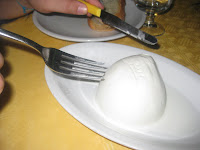Typically, ingredients that come on focaccia bread are herbs, olive oil, cheese, meat, pesto, tomatoes, olives, and a variety of other vegetables. It is a very popular snack or side dish in Italy. While in Cinque Terre, I ordered focaccia twice: one with pesto and tomatoes and the other with herbs. My friends got it with cheese on top or just plain.


Here is a recipe on how to make Focaccia bread: quick and easy.
Ingredients
- 2 3/4 cups all-purpose flour
- 1 teaspoon salt
- 1 teaspoon white sugar
- 1 tablespoon active dry yeast
- 1 teaspoon garlic powder
- 1 teaspoon dried oregano
- 1 teaspoon dried thyme
- 1/2 teaspoon dried basil
- 1 pinch ground black pepper
- 1 tablespoon vegetable oil
- 1 cup water
- 2 tablespoons olive oil
- 1 tablespoon grated Parmesan cheese
- 1 cup mozzarella
Directions
- In a large bowl, stir together the flour, salt, sugar, yeast, garlic powder, oregano, thyme, basil and black pepper. Add in the vegetable oil and water after the dry ingredients have been mixed together.
- When the dough has pulled together, knead until smooth and elastic with a little bit of flour on a hard surface. Oil a large bowl and place the dough in the bowl to get it covered with oil. Cover the dough with a damp cloth, and let rise in a warm place for 20 minutes.
- Preheat oven to 450 degrees F. Punch dough down and place on greased baking sheet. Pat the dough into a 1/2 inch thick rectangle. Brush top with olive oil. Sprinkle with Parmesan cheese and mozzarella cheese (if you want cheese on top).
- Bake in preheated oven for 15 minutes, or until golden brown. Serve warm.
Next time you go to Northern Italy, buy a slice of focaccia bread, it will make your day!


















